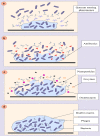Bacteriophage therapy against Pseudomonas aeruginosa biofilms: a review
- PMID: 32998720
- PMCID: PMC7528332
- DOI: 10.1186/s12941-020-00389-5
Bacteriophage therapy against Pseudomonas aeruginosa biofilms: a review
Abstract
Multi-Drug Resistant (MDR) Pseudomonas aeruginosa is one of the most important bacterial pathogens that causes infection with a high mortality rate due to resistance to different antibiotics. This bacterium prompts extensive tissue damage with varying factors of virulence, and its biofilm production causes chronic and antibiotic-resistant infections. Therefore, due to the non-applicability of antibiotics for the destruction of P. aeruginosa biofilm, alternative approaches have been considered by researchers, and phage therapy is one of these new therapeutic solutions. Bacteriophages can be used to eradicate P. aeruginosa biofilm by destroying the extracellular matrix, increasing the permeability of antibiotics into the inner layer of biofilm, and inhibiting its formation by stopping the quorum-sensing activity. Furthermore, the combined use of bacteriophages and other compounds with anti-biofilm properties such as nanoparticles, enzymes, and natural products can be of more interest because they invade the biofilm by various mechanisms and can be more effective than the one used alone. On the other hand, the use of bacteriophages for biofilm destruction has some limitations such as limited host range, high-density biofilm, sub-populate phage resistance in biofilm, and inhibition of phage infection via quorum sensing in biofilm. Therefore, in this review, we specifically discuss the use of phage therapy for inhibition of P. aeruginosa biofilm in clinical and in vitro studies to identify different aspects of this treatment for broader use.
Keywords: Antibiofilm effects; Bacteriophage; Biofilm; MDR P. aeruginosa.
Conflict of interest statement
None to declare.
Figures

Similar articles
-
Activity of Bacteriophages in Removing Biofilms of Pseudomonas aeruginosa Isolates from Chronic Rhinosinusitis Patients.Front Cell Infect Microbiol. 2017 Sep 22;7:418. doi: 10.3389/fcimb.2017.00418. eCollection 2017. Front Cell Infect Microbiol. 2017. PMID: 29018773 Free PMC article.
-
Antibiofilm potential of purified environmental bacteriophage preparations against early stage Pseudomonas aeruginosa biofilms.J Appl Microbiol. 2019 Jun;126(6):1657-1667. doi: 10.1111/jam.14241. J Appl Microbiol. 2019. PMID: 30825355
-
Combinations of Bacteriophage Are Efficacious against Multidrug-Resistant Pseudomonas aeruginosa and Enhance Sensitivity to Carbapenem Antibiotics.Viruses. 2024 Jun 21;16(7):1000. doi: 10.3390/v16071000. Viruses. 2024. PMID: 39066163 Free PMC article.
-
Pathogenic factors of Pseudomonas aeruginosa - the role of biofilm in pathogenicity and as a target for phage therapy.Postepy Hig Med Dosw (Online). 2017 Feb 14;71(0):78-91. doi: 10.5604/01.3001.0010.3792. Postepy Hig Med Dosw (Online). 2017. PMID: 28258668 Review.
-
Phage-Based Therapy in Combination with Antibiotics: A Promising Alternative against Multidrug-Resistant Gram-Negative Pathogens.Pathogens. 2024 Oct 14;13(10):896. doi: 10.3390/pathogens13100896. Pathogens. 2024. PMID: 39452768 Free PMC article. Review.
Cited by
-
Genetically engineered phages and engineered phage-derived enzymes to destroy biofilms of antibiotics resistance bacteria.Heliyon. 2024 Aug 3;10(15):e35666. doi: 10.1016/j.heliyon.2024.e35666. eCollection 2024 Aug 15. Heliyon. 2024. PMID: 39170521 Free PMC article. Review.
-
Global Cluster Analysis and Network Visualization in Prosthetic Joint Infection: A Scientometric Mapping.Orthop Surg. 2023 Apr;15(4):1165-1178. doi: 10.1111/os.13681. Epub 2023 Mar 1. Orthop Surg. 2023. PMID: 36855945 Free PMC article.
-
Capsid structure of bacteriophage ΦKZ provides insights into assembly and stabilization of jumbo phages.Nat Commun. 2024 Aug 2;15(1):6551. doi: 10.1038/s41467-024-50811-1. Nat Commun. 2024. PMID: 39095371 Free PMC article.
-
Phage Therapy in a Burn Patient Colonized with Extensively Drug-Resistant Pseudomonas aeruginosa Responsible for Relapsing Ventilator-Associated Pneumonia and Bacteriemia.Viruses. 2024 Jul 5;16(7):1080. doi: 10.3390/v16071080. Viruses. 2024. PMID: 39066242 Free PMC article.
-
How Effective Is Phage Therapy for Prosthetic Joint Infections? A Preliminary Systematic Review and Proportional Meta-Analysis of Early Outcomes.Medicina (Kaunas). 2024 May 9;60(5):790. doi: 10.3390/medicina60050790. Medicina (Kaunas). 2024. PMID: 38792972 Free PMC article.
References
-
- Shariati A, Azimi T, Ardebili A, Chirani A, Bahramian A, Pormohammad A, Sadredinamin M, Erfanimanesh S, Bostanghadiri N, Shams S. Insertional inactivation of oprD in carbapenem-resistant Pseudomonas aeruginosa strains isolated from burn patients in Tehran Iran. New Microbes New Infect. 2018;21:75–80. doi: 10.1016/j.nmni.2017.10.013. - DOI - PMC - PubMed
-
- Bahramian A, Khoshnood S, Shariati A, Doustdar F, Chirani AS, Heidary M. Molecular characterization of the pilS2 gene and its association with the frequency of Pseudomonas aeruginosa plasmid pKLC102 and PAPI-1 pathogenicity island. Infect Drug Resist. 2019;12:221. doi: 10.2147/IDR.S188527. - DOI - PMC - PubMed
-
- Wagner V, Filiatrault M, Picardo K, Iglewski B: Pseudomonas aeruginosa virulence and pathogenesis issues. Pseudomonas genomics Mol Biol. 2008:129-158
Publication types
MeSH terms
Substances
LinkOut - more resources
Full Text Sources
Other Literature Sources

